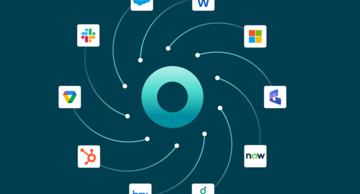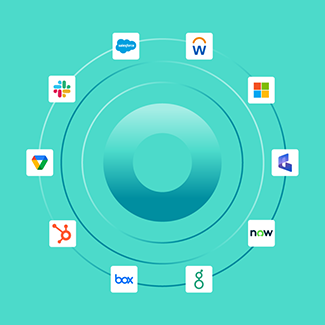Scale automation with the OneSpan Integration Platform

A typical business uses an average of 342 SaaS applications. The vast number and types of applications makes it hard for IT teams to effectively maintain performance and security.
On top of that, employees struggle to complete their work while navigating between numerous applications, especially when so many of these applications are utilized for end-to-end business processes.
Organizations are looking for modern solutions that make their business processes seamless, while also being cost effective to develop and maintain.
Traditional eSignature integration challenges
Traditional eSignature solutions often offer limited digital agreement use cases and integration capabilities. They require integrations that demand significant developer resources to ensure the solution is accurately integrated into an organization’s operational process.
This takes time and resources away from other activities where developers would be better off spending their time.
Additional challenges associated with traditional eSignature integrations include:
- Complex, heavy projects: Integrating the eSignature solution through API/SDK across an entire ecosystem is complex, requires time, and has many dependencies. You need to ensure the integration is done correctly across various systems and applications that cover all business workflows.
- Security: Connecting to multiple systems and applications creates new integration points, each of which could introduce security vulnerabilities that attackers could exploit.
- Expensive: The primary objective for today’s organizations is value optimization, yet these heavy technology implementations can substantially drive up budgets. Even large organizations don’t want to invest in their own development and expect this to be covered by the vendor.
The need for change
Rather than investing in costly, complex, custom integrations, the industry has shifted its focus to a new approach: building configurable workflow integrations that are easy to develop and maintain. These out-of-the-box configurable integrations create a streamlined and cost-effective approach to elevate productivity.
Advantages:
- Increase business agility: By using a single powerful automation solution, you can cover multiple use cases across the organization. This means that when new applications are added to an ecosystem, you can quickly create eSignature workflows without significant time or resources.
- Ease configuration: Pre-built integrations are low-code solutions, which means you don’t need significant coding knowledge. This streamlined integration also increases the ROI of the solution through reduced costs.
- Mitigate risk and keep sensitive information safe. Connect seamlessly through a single platform to reduce dependencies and eliminate potential security vulnerabilities that may occur with complex custom integrations.
Additionally, since features are built directly into the product, pre-built integrations often incorporate security and compliance risk mitigation. These built-in capabilities ensure sensitive information is kept safe by using methods like end-to-end encryption and comprehensive authentication.
A new approach to integrations
Unlike legacy industry offerings, the OneSpan Integration Platform is a modern platform that offers a low-code/no-code approach to implement an eSignature solution directly into existing workflows without the need for developer resources.
For example, once activated by our team, the storage integrations are directly available in the OneSpan Sign interface, meaning that to be included in the workflow, customers need only select the preferred application integration from a drop-down menu.
The platform has the ability to support a comprehensive list of 1,000 application integrations, all of which are easily adaptable to users’ unique workflows.
The convenience and accessibility of pre-built integrations through the OneSpan Integration Platform enables customers to increase their business agility with a single automated solution that covers multiple use cases across the organization.
Because they are pre-built and easily customizable to meet unique business needs and workflows, the integrations can easily scale and evolve to meet changing business needs.
Increase business agility and mitigate risk
The OneSpan Integration Platform ensures customers can enjoy greater eSignature security and ease of use with a seamless integration directly into their existing workflows. Pre-built integrations are also pre-tested to provide customers with confidence that the integrations won’t allow any security loopholes and will keep sensitive information safe.
An organization in the hospitality industry is projected to recognize 90% cost savings with OneSpan’s built-in risk and compliance features. Additional estimates include saving over $100,000 after switching from a traditional eSignature vendor to a pre-built integration from OneSpan.









